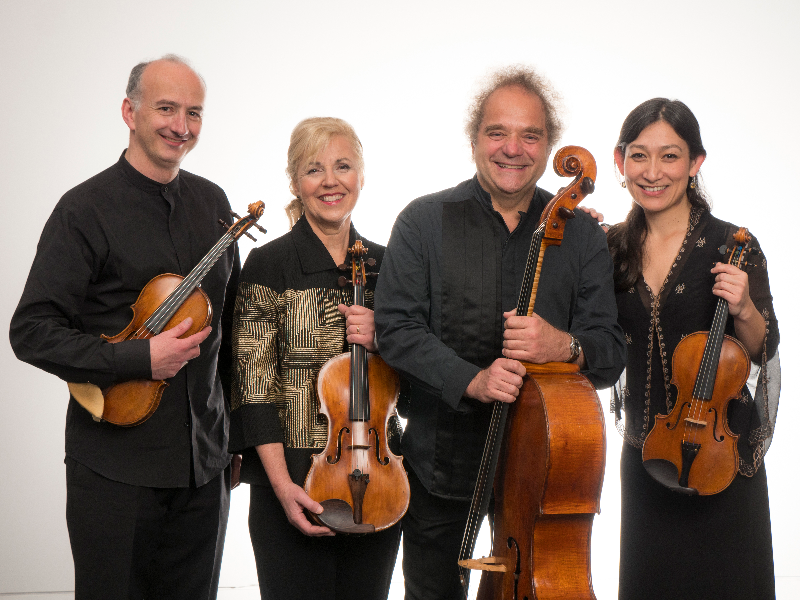by Daniel Hathaway

Although inevitable personnel changes over the years have steadily moved the Takács Quartet away from its Hungarian roots — the group was formed in Budapest in 1975 — the Quartet, now in residence at the University of Colorado in Boulder, remains one of the most distinguished ensembles in the chamber music business, and a great favorite of the Society. Their concert at Plymouth Church on April 9 showed why.
Merely in terms of programming, Haydn’s cheerful and unusual Quartet in d, Op. 76, No. 2 made a dramatic contrast with Shostakovich’s brooding Quartet No. 4. And Grieg’s sole completed — and rarely performed — string quartet, Op. 27 in g minor, ended the evening with a torrent of imaginative Nordic material. New second violinist Harumi Rhodes fitted into the ensemble seamlessly, joining first violinist Edward Dusinberre, violist Geraldine Walther, and founding cellist András Fejér.
Both Shostakovich and Grieg imported folk elements into their works on this evening’s program — Klezmer tunes and Norwegian traditional music, respectively. In the Russian composer’s case, that, along with Dusinberre’s lyrical solos in the Andantino, provided respite from the generally dark character of the work. In the Grieg, folk music melds perfectly with the composer’s own language. The Takács went straight to the expressive core of both quartets and, though different, put each of them across with their signature elegance.

From the first attention-grabbing gestures of Bozza’s En forêt, through Plog’s etude-like Three Miniatures, to the last notes of the “Envoi” of Knussen’s Horn Concerto that ended the demanding first half of the program, Caballero flawlessly made his way through a whole catalogue of horn techniques. Ojeda supplied him with robust, crisp piano support that was particularly impressive in the reduction of Knussen’s orchestra score.
If Caballero had kept the audience on the edge of their pews before intermission, he allowed them to sit back and relax in the second half of his program. That began with his arrangement of Brahms’ Intermezzo, Op. 118, No. 2 inspired by a performance the recitalist had heard for horn and harp. Afterwards, he mock-apologized to pianists for appropriating their material, but that was hardly necessary. His gorgeous tone and phrasing made their own case for an arrangement that almost instantly reduced the intensity level of the program.
To close out the evening, the Pittsburgh Symphony principal horn joined DeAlmeida and Ojeda, principal oboe and principal keyboard, in Carl Reinecke’s Trio in a, an 1886 work from the pen of a prolific composer who taught such wildly disparate students as Albéniz, Janáček, and Sir Arthur Sullivan.
The three musicians have a long history of performing together in the Pittsburgh orchestra — 30 years for Caballero and DeAlmeida, and 12 for Ojeda. That was obvious in their ensemble playing, but also in their easy stage presence. The wind players traded repartée while shaking the condensation out of their instruments. (DeAlmeida, playing a warmup figure after Caballero’s prefatory remarks: “He talked a long time and my reed was drying out!”)
The trio dug deep into the Reinecke, giving it the impression of more musical profundity than it probably deserves, but the audience was hooked. They even laughed out loud at the end of the terse Scherzo.
Responding to a long, warm ovation, William Caballero sent the audience into the misty spring night with a simple Persian folk tune by Carnegie-Mellon faculty composer Reza Vali.
In remarks before the program, president Murray Goldstone announced details of the Society’s 70th season — nine concerts rather than the usual seven, three of which will feature James Ehnes and Andrew Armstrong in Beethoven’s complete sonatas for piano and violin. Those will be held at the Maltz Performing Arts Center, as will a recital by the Albers Trio with violinist David Bowlin and violist Yura Lee. Performances at Plymouth Church will be given by the Jerusalem Quartet, the Dover Quartet, the Apollon Musagète Quartet, and Chanticleer. Pianist Till Fellner will move the series to CIM’s Mixon Hall for a single evening.
Published on ClevelandClassical.com May 1, 2019.
Click here for a printable copy of this article



